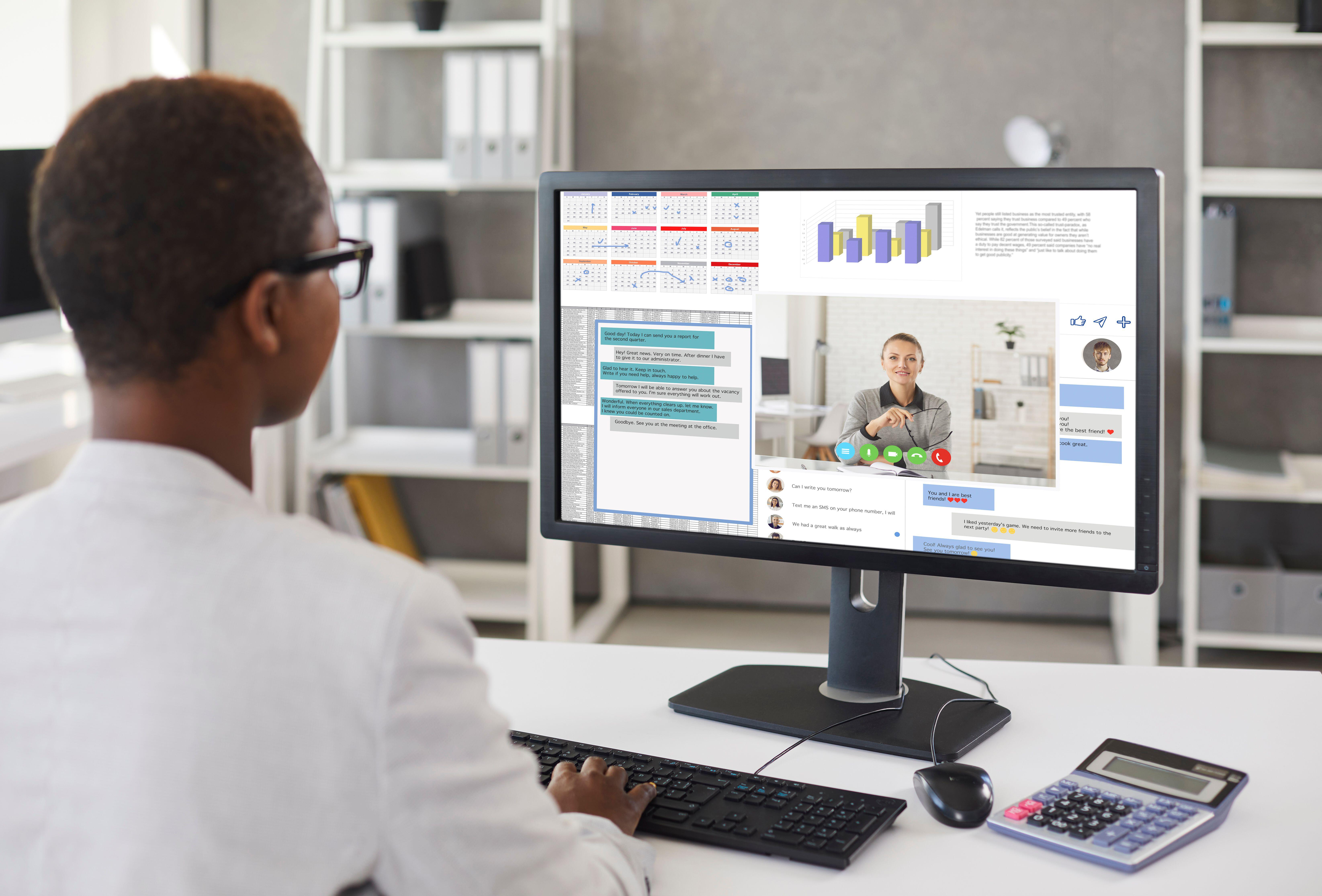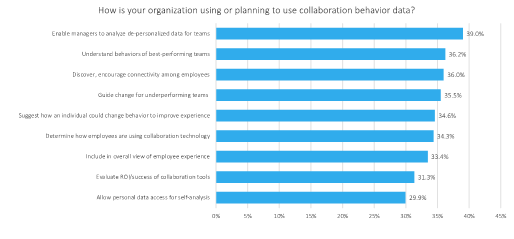Video meetings are business as usual these days, but not all companies are reaping full value from this mode of collaborative work. Many fail to take advantage of what video meetings can tell them about how employees behave throughout the day, and therefore are missing out on the opportunity for data-driven decision making.
Collaboration data is one of the data types that most companies have at their disposal for gaining insight into employee experience. In analyzing collaboration data, team leaders, IT, HR, and other business managers can gain an overview of how often, in what ways, and with whom employees are digitally interacting throughout the day via applications such as team chat and video meetings. Optionally, employees see their own collaboration data for an individualized view on usage and positive and negative behavioral patterns.
Of the 500 companies that participated in Metrigy’s global Employee Experience: 2023-24 research study, 53% are using collaboration data. This is the second most-used type of data, behind engagement data, which 61.3% of companies use. Engagement data gathered from enterprise social networking and elsewhere shows how much an employee participates and engages digitally with the company and peers. The two types of data, along with employee sentiment—in use by 51.7% of companies—help form a well-rounded view of employee experience.
But understanding employee behavior is just the first step. Additional value comes for companies that use the data to guide their employees toward positive improvements in factors such as productivity and wellness that affect their overall experience. Team leaders or HR executives might evaluate the collaborative behavior of the best-performing teams against the collaborative behavior of under-performing teams, for example.
Companies already using collaboration data can analyze the data from video meetings to understand meeting behavior, based on factors such as number of participants, frequency, and duration. Analyzing the data can tell them:
- Who’s meeting? Roughly 44% of companies want to understand how teams are getting together. For example, are scheduled meetings among all team members or different groups within a team? Thirty percent or so want to know the breakdown between scheduled and ad-hoc meetings, as well as get insight into 1:1 meetings, while 27.1% want perspective on external meetings.
- How are they behaving during meetings? In terms of in-meeting behavior, companies most want to understand time spent in active vs. passive participation (40.4%) and the frequency of meetings starting and stopping on time (32%). Timeliness of joining is important to understand for 22.3%, and video and mute on/off for at least 15%. This sort of data could come in handy for setting meeting policies, such as duration or no-meeting days, as well as help team leaders and other managers figure out which types of meetings work best for which types of teams or topics.
- What features are they using? Video meeting apps come with a host of interaction mechanisms, and 36% of companies want to know whether employees are using them. These include the use of polls, chats, whiteboards, and emoticons like thumbs-up/down, smiley or frowny faces, hearts, and the like. This is a great way to assess in-the-moment employee sentiment. Nearly 30% want to understand how employees are using AI features like transcription, note taking, and summarization.
- What devices are they using? Employees use a variety of devices to join and participate in meetings, from headsets to webcams, room systems, and so on. In this study, 36.4% of companies say they’d like to understand what devices are in use. With this data, they can also run correlations—are employees using headsets more engaged during meetings, for example?
When looking to evaluate the collaborative behavior of the best-performing teams against the collaborative behavior of under-performing teams, the data can help companies answer many types of questions:
- Do members of the best-performing teams participate actively at a higher rate than those in under-performing teams, or take advantage of interactive features more so than others?
- Are under-performing teams meeting too often, or not often enough, comparatively?
- Do team members proactively connect and engage with each other throughout the week, 1:1, or do they only communicate during scheduled meetings or formal conversations?
With an understanding of behavioral differences, they can then guide under-performing teams to emulate the behavior of high-performing teams—and make ongoing suggestions for all teams as success measures change over time. Analyzing de-personalized data for teams, understanding behaviors of best-performing teams, and guiding change for underperforming teams are among top uses for collaboration behavior data.
Value comes from the use of collaboration data in other ways, too. Of those using collaboration data, more than half do so to solidify technology device requirements, plan workplace strategy, and set HR policies. Another 42% or more use collaboration data to optimize software licensing and to guide facility planning. Given the relative ease of access companies have to this data—from the apps themselves, collaboration devices, and collaboration management software, for example—there’s little reason not to gather, analyze, and take action on collaboration data today.
Join us on Tuesday, March 26, at Enterprise Connect for Finding the Hidden Value in Your Collaboration Data, where we’ll discuss these topics and much more!
Enterprise Connect 2024 will be held at the Gaylord Palms in Orlando, FL, from March 25-28. Preview the conference schedule or register to attend. To keep on top of all Enterprise Connect developments, subscribe to the weekly newsletter.










